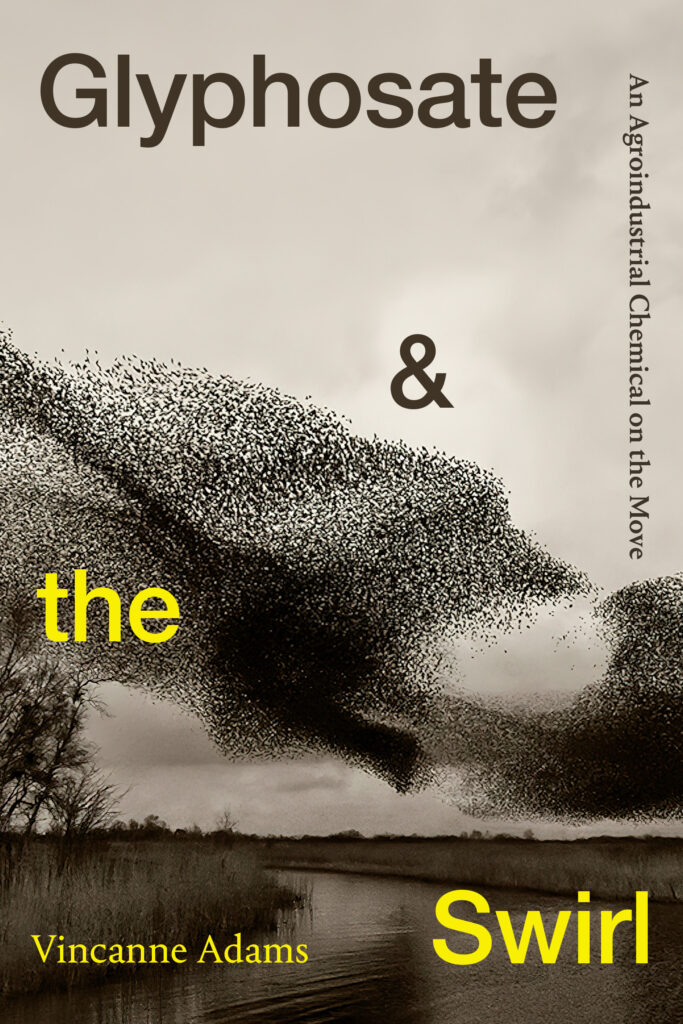Reviewed Book
Glyphosate & the Swirl: An Agroindustrial Chemical on the Move By Vincanne Adams, Durham, NC: Duke University Press. 2023. pp. 184.

Nicholas Shapiro
University of California, Los Angeles
At your last bathroom break, you likely deposited a thousand times the concentration of glyphosate into the toilet than anyone did 30 years ago. This nonselective herbicide—effective in killing across plant species—has worked its way so deeply into late industrial food systems that it has reached a near ecological omnipresence. Are these synthetic molecules ‘designed to swiftly lay waste within the plant kingdom’ also wreaking some sort of slow-motion biological havoc to humans as they careen through our bodies on a daily basis? Are the crops that have been genetically modified (GM) for decades to be resistant to this compound’s lethality perturbing our bodies and contributing to the large-scale increase in chronic disease that roughly coincides with their introduction? These are the questions that have animated thousands of pages of research on glyphosate and the GM seeds that often enter the soil, and later human bodies, together. In Glyphosate and the Swirl: An Agroindustrial Chemical on the Move, Vincanne Adams charts the morphology of this vast amount of research and the expectations held by multiple publics for what truth claims emerging from these studies should look like.
A central focus aspect of Adams’s analysis is the idea of the scientific consensus. Glyphosate’s informational gyre has an almost antithetical relationship to consensus, industry, and public incredulity, even more so than climate change or tobacco. While there is variability in the field, by and large scientific studies point toward the human safety of glyphosate and GM crops. Public concern in many countries vastly outstrips this general (but not absolute) scientific assertions of safety. In a sharp and brilliantly framed departure from Merchants of Doubt (Oreskes and Conway 2010), Adams outlines that the shortcomings of assuming doubt is the sole tool of industry and that science studies scholar should dutifully align with any scientific consensus. A key chapter rather stunningly analyzes how a highly prestigious scientific panel selectively navigates the swirl of research on herbicide-laden GM crops to produce a widely circulated and ostensibly conclusive consensus statement on their safety. Adams details how research is “packaged for comparison to create a preponderance of evidence in one direction” (83), including the centering of edge cases, double counting some studies by citing their original form and the metanalyses that they inform, making comparisons with incorrect assumptions of difference, and more. This chapter could be the basis of a powerful introduction to science and technology studies class exercise where the class reads the scientific chapter in question and collectively assesses the packaging of knowledge along the lines of Adams’s analysis. Adams does not attempt to swing the pendulum in the opposite direction by asserting that, since there are systematic flaws in claims to clear safety, they must, in fact, be harmful. Rather, she nudges the reader away from demanding such binary conclusions for this form of toxicity. Navigating a body of research that does not easily settle requires a different set of analytical tools than merely tracing genealogies of doubt, leading her to a “refusal of singular claims to truth” (111).
In a salient reflexive turn, the book’s origins lie in Adams’s own clearcut arguments against GM foods and glyphosate in a previous book she coauthored with a passionate pediatrician. With her erstwhile MD coauthor now an interlocutor, Adams drops the single-direction sieve through which she had previously forced her empirical material and unleashes the more indeterminate determinations of “the swirl.” With this concept, she “foregrounds the clustering of knowledge in relation to the expectations we hold for it,” which enables “us to trace their pluri-potentiality” (110). Releasing grip on univocal knowledge formations in the pursuit of more symmetrical analyses can be uncomfortable. The idea of the swirl, too, can be frustrating, as it is not fully clear the degree to which an inability for knowledge to settle is driven by the chemical’s low velocity or nontoxicity or by dozens of industry epistemological leaf blowers just out of frame, maintaining the suspended ambivalence. And perhaps that frustration is one of the lessons the book teaches us about our own investments in a tidier, more certain story.
Drawing upon the knowledge swirl is the archipelago of regulatory fiefdoms that are tasked with making (or not making) rules to protect environmental health. Adams details how the GM industry marketed its products as different enough to patent but not different enough from unmodified crops to be regulated, revealing the absurdity of the way late industrialism has divvied up vital relations across feeble and perpetually out-of-jurisdiction regulators.
The book is also importantly a lesson in reading vast literatures together. The target audience for Glyphosate and the Swirl is much more squarely academic than Adams’s previous trade book, yet it is still accessible beyond the disciplinary bounds of anthropology. The book provides an excellent inroad for doctors and medical students into critical epistemological approaches to thorny multidisciplinary and multisystems problems without having to endure a jargon hazing. Adams generously draws together the thoughts of a wide range of scholars with a citational density that I rarely see in full professors. An important meta contribution of the book is also the example it sets for how to work a hyper-researched object, which can be especially instructive for anthropology grad students as they work to narrate the overwhelming and sometimes countervailing narratives that emerge from any field site.
Reference
Oreskes, Naomi, and Erik M. Conway. 2010. Merchants of Doubt: How a Handful of Scientists Obscured the Truth on Issues from Tobacco Smoke to Climate Change. New York: Bloomsbury.